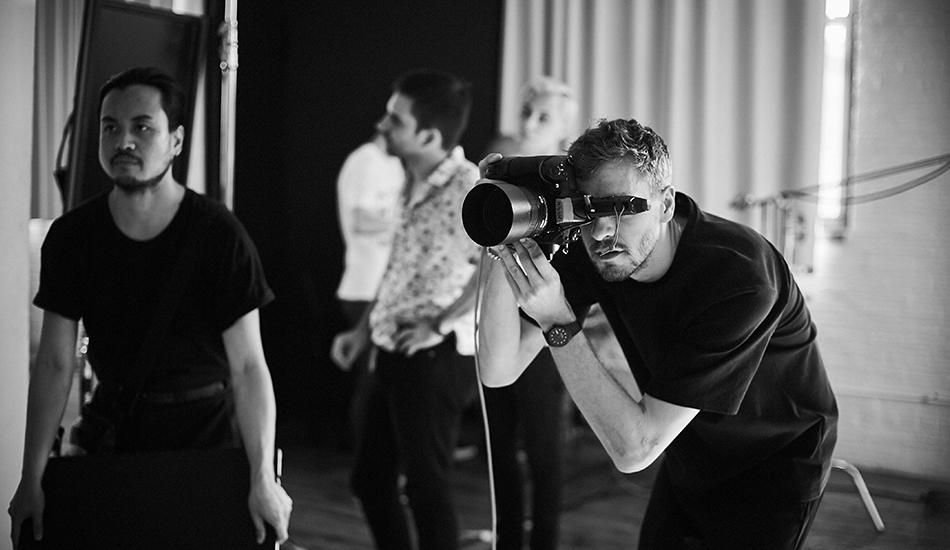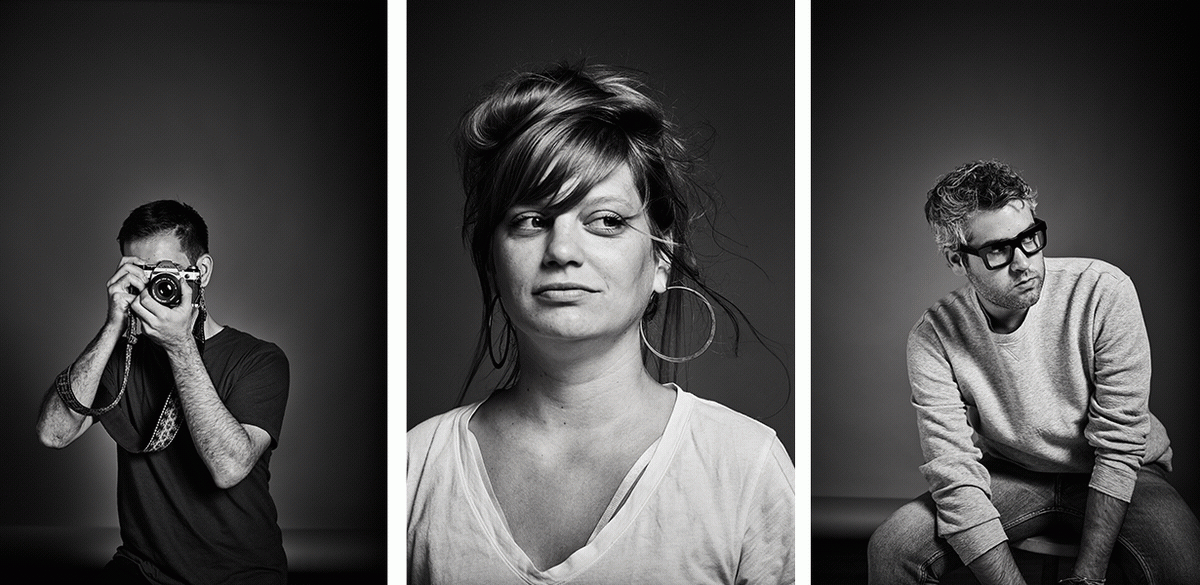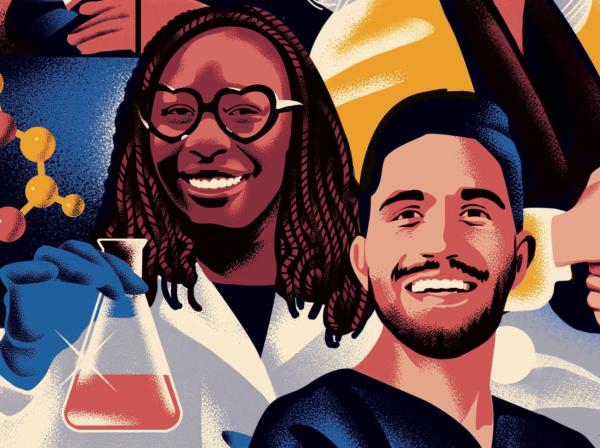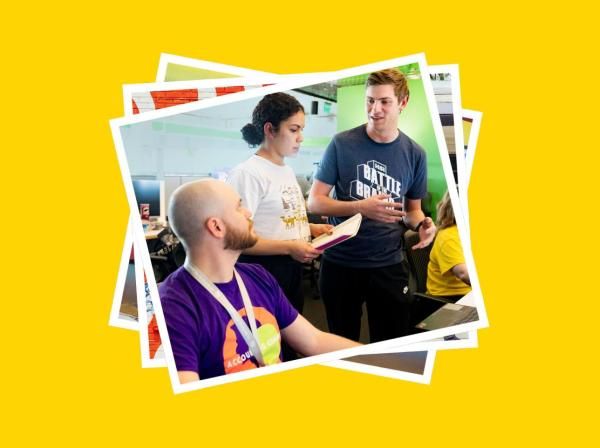Shooting Stars
It’s a hot New York summer night, and Brandon Maxwell ’08, fashion designer and celebrity stylist, is casting his eye across a bruising Brooklyn sky. Across the room, a flash stutters above one of his best friends as she works the camera. The room thrums. Music plays in the background while a group of Austin transplants shout advice and pose for pictures. They rearrange one another, boss one another around and see things through one another’s lenses.
A producer for Condé Nast cues up a personal project he has been working on for creative input. A visual storyteller for VICE Media lingers over the shoulder of the shoot’s photographer, trying not to offer too much advice. In college, these friends formed a tightknit group. As adults, they’re making it in New York City. The threads of hard work, art and friendship have tied them together. They ground one another — and serve as one another’s ladders.

Ryan Slack ’08 and Christian DeVoe ’10 have a rhythm. Shoot, rearrange the product, upload. While the two were roommates years back, today it’s mostly business: Slack shoots and DeVoe and his team begin the detailed and highly technical post-production process. Together they’ve worked for companies such as Amazon, Barneys, Bonobos and Loeffler Randall.
Slack moved to New York in September 2009, around the same time as Monika Kratochvil ’08 and Matt Ellis ’07, with the intention of becoming a professional photographer. In Texas, he was assisting a photographer and shooting on his own for clients such as Red Bull, for which he’d capture extreme skateboarders and the like. In New York, he was often on set with 30 other people. “It really opened my eyes to the scope and gravity of the commercial photography industry,” says Slack.
He took an internship with celebrity photographer Ben Baker, known for his portraits of presidents and politicians, and eventually became his assistant. When Slack began assisting a commercial photographer, he had an epiphany: Celebrity photography might be a labor of love, but shooting for catalogs and e-commerce was far more profitable.
If the work seemed unromantic, the opportunity was not. E-commerce was just taking off. Today the work he does alternates between high-fashion campaigns and the practical — fashion photography that makes clients long for a look, plus pictures of the front and back of the shirt so they know what they’re buying.
Slack attributes much of his success and willingness to take risks to how the Photocommunications program at St. Edward’s integrates art with real-world knowledge — and especially to Professor of Photocommunications Bill Kennedy’s Professional Practices course, which taught him business skills. “I can open that notebook now, and everything makes more sense than ever,” he says. “It’s the class I use every day in my real life.”
When he reflects on how he made it, Slack can’t help but think of Kennedy telling him that if he wanted to stay in Austin and be “that guy,” it would be possible, but he’d have to work 10 times harder than the guy in New York — and the guy in New York is the hardest-working guy there is.
Back in Austin, DeVoe met John Clendenen ’08, who was retouching images from an award-winning underwater fine art photographer at the time. The two worked well together and kept in touch after Clendenen left for New York. When DeVoe was ready to move, Clendenen helped him secure an internship at a photo-retouching studio, where DeVoe ascended to production manager during the three years he was there.
In 2014, DeVoe launched his company, Local Color, a creative studio that offers retouching services, as well as e-commerce photography solutions for clients such as Nike, Tory Burch, Aesop and Swarovski, among others. While Slack used to feed jobs to DeVoe while he was working elsewhere, today they work together on numerous projects throughout the month. The two just collaborated on a web campaign for Barneys New York, for example.

From left to right: Matt Ellis, Monika Kratchochvil, Christian DeVoe, Brandon Maxwell, Jaime Alexis, Jessy Price, Michelle Leedy and Ryan Slack
When Clendenen arrived in New York, he accepted an internship at Bespoke Digital, a retouching and digital post-production studio, which he found through a friend of Slack’s. He worked his way up to retouching and digital tech, and today, he’s a senior retoucher at the advertising agency Droga5, where he works alongside Michelle Leedy ’08.
The type of retouching Clendenen does is the painstaking type: color correcting, fine-tuning minute details or assembling dozens of nearly identical pictures to create one perfect high-resolution image. And while retouching can reinforce unrealistic impressions of women in the fashion world, in advertising, it’s more about technicalities — as with a campaign for a device launch they worked on recently. “We’ve done a good job when you can’t tell we did anything at all,” says Clendenen.
Leedy came to New York for an MFA, which she earned from Bard College’s International Center of Photography in 2011. After working for photographer David LaChapelle for two years, she moved to Bespoke, where she worked with DeVoe and Clendenen before joining Droga5 in 2015. As Droga5’s retouching studio manager (she oversees Clendenen and four other retouchers), she’s one step removed from the day-to-day details of the retouching business, which gives her breathing room to make art on her own.
For her, art spills across mediums. She has performed improv, is working on a project that centers on the physical and emotional concept of “boxing out” (like in basketball), and, every Saturday morning, makes a short video she calls “maintenance” for her Instagram account.
She says she “found [her] brain” at St. Edward’s. “It gave me the hunger to get my MFA. I wanted to go out and make other things and to look at things critically,” she notes. And, while she credits her work ethic to her family, she attributes her drive to her professors, who pushed her harder the more they saw her trying.
Her informal degree in friendship has also served her well. “I like to think that that school and that program gave me the tools to help figure things out,” she says. “And if not all the tools, then definitely the friends to help me figure it out.”
Among those friends, Leedy and DeVoe have breakfast regularly, and she’s close to Maxwell, Kratochvil and Jaime Alexis ’07 (daily texts keep them in touch).
Maxwell says: “Jaime is always good for setting it straight. You can talk to her, and she’ll be like, ‘No, this isn’t what you deserve. You shouldn’t accept it, and you should move on.’ And to have that sort of group around you that is realistic and builds you up — well, I could go on for days.”
Alexis began her production career in the gear room at VICE Media, checking out equipment for production teams. These days, she’s a staff shooter and associate producer at VICE, where she wears many hats. She shoots, directs and oversees projects from inception to airdate. Most recently, she’s been working on a 10-part documentary series on modern etiquette, which will explore the concept through the lens of visual storytelling.
“I think what interests me most about my job is that, at least for a short time, I get to be part of people’s lives,” says Alexis.

Like Leedy and Alexis, the audaciously ambitious Kratochvil is also at every show of Maxwell’s eponymous fashion brand, albeit in a different capacity. She shoots all of Maxwell’s behind-the-scenes footage.
Until recently, Kratochvil was a fashion and photography director for an e-commerce apparel company. When she first arrived in New York, she worked as a nanny until she landed a job in a PR agency with Maxwell’s help.
Kratochvil says the hours upon hours spent in the Photocommunications lab at St. Edward’s prepared her for the long days, constant deadlines and nonstop multi-tasking required in New York’s cutthroat creative industries.
Her degree, combined with her on-the-job experiences, served her well when Jessy Price ’08 connected her with a position on the night crew at the prestigious Milk Studios. She handled props, managed equipment, and supported requests from photographers, models and the creative team.
“That’s really a show-up, work-long-hours, kill-yourself kind of job,” interjects Alexis, who started off in an equipment room herself.
Before long, Kratochvil moved on to a stylist-assistant position at Bonobos, where Slack worked as an assistant to a photographer at the time. After demonstrating her skills for getting a studio organized and making the company money, she became studio manager. Eventually, she became a fashion and photography director and was Slack’s boss for three years.
“Monika is a legend. She basically started as the clothing steamer, and she ended as the queen of the photo department, hiring and firing photographers, plus telling people how to pose,” says Slack.

After six years, though, Kratochvil seemed to hit a ceiling. She felt her growth was at a standstill.
At St. Edward’s, social justice themes were woven throughout her coursework. She reflects on how some of her communication courses addressed equal rights and “how much work women had to do to be heard in a society that doesn’t project that voice.” When Kratochvil’s boss told her to be more “rainbows and roses,” it all came back to her. She gathered her courage and took a leap. She quit the job and launched her own freelance photography business last January. She shoots everything from courthouse weddings to magazine profiles, and she’s the force responsible for the behind-the-scenes photos that populate Maxwell’s social feed and website.
Ellis, Kratochvil’s boyfriend, is fiercely proud of her and her work, and he knows good photography when he sees it.
In 2010, less than a year after arriving in New York, Ellis won Photo District News’ Billboard Ultimate Music Moment Photo Contest with a picture of The Black Keys onstage in Chicago. He was working with magazines like Spin and Rolling Stone and assisting on productions with people like Annie Leibovitz and Steven Meisel when he met fashion and celebrity photographer Guy Aroch.
Today, as Aroch’s first assistant and technician — Ellis not only shoots but is also the digital tech and handles lighting — he spends more time traveling than at home. But it’s worth it: He is especially proud of the work the Aroch team did on Coca-Cola’s recent rebranding. “It’s cool to drive down the road and see a picture, billboard size, and know it’s something you worked on,” he says.
Price arrived in New York in October 2008 and got his first break because he listed a summer job processing film at CVS on his résumé. The digital director of Milk Studios loved it, and said Price was clearly a go-getter. He was offered an internship on the spot, which turned into a full-time job four months later.
Price knew he needed to stand out from photography graduates from schools across the country. He realized his education in print and inkjet printing at St. Edward’s was that differentiation, and that Milk wasn’t doing enough of it. “I pushed that [inkjet printing] and owned it, and I think they started to see I knew what I was talking about,” he says. He went headlong into print for a long time, and ended up as a retouching producer at Milk for three years.
Meanwhile, he was nursing a dream of becoming a fashion magazine photo editor, which he achieved in 2014 when he became associate photo editor at W. Now a producer at 23 Stories at Condé Nast, he does all the sorts of things he did at W — hiring photographers, going on set, keeping shoots on schedule — for video for Condé Nast’s branded content business.
On the side, Price began making his own short films and posting them on social media. His first boss at Milk Studios was watching. Impressed, he texted Price an offer: anything you need — equipment to behind-camera talent — for an entire day, so long as you make something with it.
Price knew what that something was: Maxwell needed an advertising campaign, and Price wanted to produce it. The two, who worked together constantly at St. Edward’s and had occasionally collaborated in New York, produced a nearly three-minute video that featured models dressed in Maxwell’s designs, lounging in bed, staring piercingly at the camera. The soundtrack was snippets of messages Maxwell’s family had left him during the grueling months he’d been launching his fashion line.
The video landed them the opportunity to produce Apple Music’s commercial for Lady Gaga’s song “A-Yo” in 2016, which funded the next campaign for Maxwell and was shot on the sidewalks of Detroit and in model Riley Montana’s childhood home. This past summer, Maxwell and Price — who are also now engaged — released a multi-video campaign for Maxwell’s 2017 Fall/Winter collection.

If they work together intuitively, they admit it wasn’t always easy. The joint work in college — projects, shoots, even sharing a large-format camera for a semester — helped them figure out how to get the best out of one another. “When you get to New York, you realize you need people that you trust. You need collaborators, and people who are going to tell you the truth, and who know your ups and downs. I think because we figured that out in college, it allowed us to have a better working relationship now,” says Price of his partnership with Maxwell.
Today, the two are back to working together, but initially Price came to New York with no expectations Maxwell, his best friend in college, would follow suit. Even now their professional lives exist in separate spheres. Maxwell began his stint in New York in 2009 as an assistant to fashion stylists (the people who select the clothing and accessories for magazine features, television, advertising campaigns and more). By 2010, he was assisting creative director Nicola Formichetti and helping dress Lady Gaga. Since 2012, Maxwell has served as her fashion director.
In 2015, Maxwell launched his own line of womenswear: Everyone from Zendaya to Karlie Kloss to Oprah has worn his designs. In 2016, Michelle Obama wore one of his gowns to a state dinner in honor of Singapore’s prime minister.
“Yes, he’s a fashion designer, but I think he would probably fit more into the league of designers who are creative directors, like Karl Lagerfeld ... people who really take control over the visual aspect as well as the design aspect, as well as the overall voice of a company,” says Price. “I think as time goes, he’ll probably be seen in that light, not only as a creator of clothes but also of many other things — video and photography and whatever else he should decide to do.”
As Maxwell evolves creatively and professionally (he’s rumored to be launching a handbag line soon), he has relied on his St. Edward’s cohort. Once a career goes skyward, as Maxwell’s has, everyone wants to hitch a wagon to that star — or try to control its trajectory. With so many of his creative and visual choices subjected to business and financial concerns, he says he sometimes needs to put his ambitions in front of those who matter most to him creatively. “Ultimately, I don’t want to look back and have lost every bit of myself and what I stand for,” he says, which is why he’ll grab Kratochvil in the middle of a shoot, close the office door and get perspective.
But there’s also pride for what the group as a whole has accomplished.

“When I walk down the street and I see a billboard that Michelle Leedy did, or turn on the TV and see something that Jaime did, or go to Barneys and see something that Ryan did, I feel a joy and a pride, but in my mind, I don’t think about them being 32. I think about them being 19. I don’t see them any different, and that’s a really humbling experience that not many people have,” says Maxwell.
As the years since college have passed and their professional lives consume more and more of their time, the group as a whole gathers a little less frequently. Yet when they do, they fall into familiar St. Edward’s patterns — sharing creative critiques, pushing one another toward stronger work, and bolstering one another’s resolve for the kind of risk-taking that has raised each so high already.
Photography by Monika Kratochvil ’08


